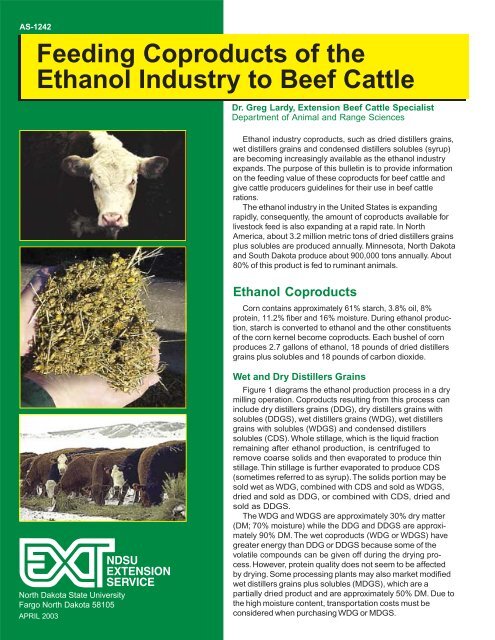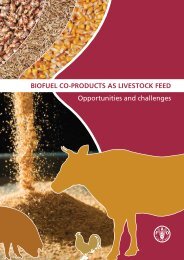Distillers Grains Feeding Recommendations. - Distillers Grains By ...
Distillers Grains Feeding Recommendations. - Distillers Grains By ...
Distillers Grains Feeding Recommendations. - Distillers Grains By ...
Create successful ePaper yourself
Turn your PDF publications into a flip-book with our unique Google optimized e-Paper software.
AS-1242<strong>Feeding</strong> Coproducts of theEthanol Industry to Beef CattleDr. Greg Lardy, Extension Beef Cattle SpecialistDepartment of Animal and Range SciencesEthanol industry coproducts, such as dried distillers grains,wet distillers grains and condensed distillers solubles (syrup)are becoming increasingly available as the ethanol industryexpands. The purpose of this bulletin is to provide informationon the feeding value of these coproducts for beef cattle andgive cattle producers guidelines for their use in beef cattlerations.The ethanol industry in the United States is expandingrapidly, consequently, the amount of coproducts available forlivestock feed is also expanding at a rapid rate. In NorthAmerica, about 3.2 million metric tons of dried distillers grainsplus solubles are produced annually. Minnesota, North Dakotaand South Dakota produce about 900,000 tons annually. About80% of this product is fed to ruminant animals.Ethanol CoproductsCorn contains approximately 61% starch, 3.8% oil, 8%protein, 11.2% fiber and 16% moisture. During ethanol production,starch is converted to ethanol and the other constituentsof the corn kernel become coproducts. Each bushel of cornproduces 2.7 gallons of ethanol, 18 pounds of dried distillersgrains plus solubles and 18 pounds of carbon dioxide.Wet and Dry <strong>Distillers</strong> <strong>Grains</strong>North Dakota State UniversityFargo North Dakota 58105APRIL 2003Figure 1 diagrams the ethanol production process in a drymilling operation. Coproducts resulting from this process caninclude dry distillers grains (DDG), dry distillers grains withsolubles (DDGS), wet distillers grains (WDG), wet distillersgrains with solubles (WDGS) and condensed distillerssolubles (CDS). Whole stillage, which is the liquid fractionremaining after ethanol production, is centrifuged toremove coarse solids and then evaporated to produce thinstillage. Thin stillage is further evaporated to produce CDS(sometimes referred to as syrup). The solids portion may besold wet as WDG, combined with CDS and sold as WDGS,dried and sold as DDG, or combined with CDS, dried andsold as DDGS.The WDG and WDGS are approximately 30% dry matter(DM; 70% moisture) while the DDG and DDGS are approximately90% DM. The wet coproducts (WDG or WDGS) havegreater energy than DDG or DDGS because some of thevolatile compounds can be given off during the drying process.However, protein quality does not seem to be affectedby drying. Some processing plants may also market modifiedwet distillers grains plus solubles (MDGS), which are apartially dried product and are approximately 50% DM. Due tothe high moisture content, transportation costs must beconsidered when purchasing WDG or MDGS.
















